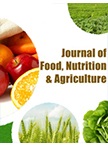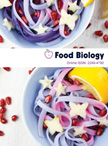Development of fibre, protein and essential nutrient rich traditional snack from incorporation of barnyard millet and soy flour
DOI:
https://doi.org/10.21839/jfna.2025.v8.9471Keywords:
Barnyard millet, Soy flour, Fiber, Protein and Mineral enriched nutria chikkiAbstract
Chikki, a traditional Indian confectionery made using groundnut and jaggery, is popular across all age groups. This study aimed to enhance its nutritional profile by developing a multigrain Nutri-chikki enriched with barnyard millet, soy flour, sesame seeds, puffed barnyard millet, dry black dates powder (iron source), desiccated carrot, coconut, sweet potato, and pumpkin and flax seeds. The nutritional content and storage stability of the Nutri-chikki were assessed. The multigrain Nutri-chikki was organoleptically evaluated using a nine-point hedonic scale with a sensory panel of 20 trained members. The results revealed that the Nutri-chikki formulations (T1, T2, T3) contained significant amounts of protein (14.78 g), fat (16.6 g), fiber (4.1 g), and minerals, including iron (9.67 mg), calcium (269.9 mg), potassium (839.75 mg), phosphorus (565.1 mg), and magnesium (462.92 mg) per 100 g, which were nutritionally superior to the control (groundnut chikki). While there were minor variations across the treatments (T1, T2, T3), the values were comparable, indicating uniformity in nutritional enhancement. The Nutri-chikki showed an overall sensory acceptability score of 8.3, outperforming the control (7.8). Storage studies at ambient (25-30 °C) and cold (4-8 °C) conditions demonstrated that the Nutri-chikki retained acceptable sensory qualities for up to 120 days, as evaluated at 30-day intervals. The findings highlight the potential of Nutri-chikki as a nutritious and shelf-stable alternative to traditional chikki, suitable for wider consumer acceptance.
Downloads
References
Abhirami, K., & Karpagapandi, L. (2018). Nutritional evaluation and storage stability of multigrain Nutri-chikki. International Journal of Chemical Studies, 6(5), 3253-3259.
AOAC. (1995). Official methods of analysis. (16th ed.). Washington, USA: Association of Official Analytical Chemists.
AOCS. (1997). Official and tentative methods for the American Oil Chemists’ Society. (7th ed.). Champaign, US: American Oil Chemists’ Society.
Bukya, A., Atole, R. R., & Virkar, M. V. (2018). Preparation and standardization of Chikki from groundnut (Arachis hypogaea) and ragi (Eleusine coracana) its storage studies. World Journal of Pharmacy and Pharmaceutical Sciences, 7(2), 1325-1330.
Chase, G. W., Ye, L., Stoakes, V. C., Eitenmiller, R. R., & Long, A. R. (2004). An inter-laboratory-verified method for the determination of vitamins A and E in milk and soy-based infant formula by liquid chromatography with matrix solid-phase dispersion extraction. Journal of the Association of Official Analytical Chemists, 87(5), 1173-1178.
Chetana, R., & Sunkireddy, Y. R. (2011). Preparation and quality evaluation of peanut chikki incorporated with flaxseeds. Journal of Food Science and Technology, 48, 745-749. https://doi.org/10.1007/s13197-010-0177-z
Coşkuner, Y., & Karababa, E. (2007). Some physical properties of flaxseed (Linum usitatissimum L.). Journal of Food Engineering, 78(3), 1067-1073. https://doi.org/10.1016/j.jfoodeng.2005.12.017
Devindra, S. B. (2015). Estimation of glycemic carbohydrates from commonly consumed foods using modified anthrone method. Indian Journal of Applied Research, 5(3), 45-47.
FAO. (2007). The Panela agro-industry in Colombia: An alternative for diversifying income for small-scale rural producers. Rome, Italy: Food and Agricultural Organization of the United Nations.
Gandhi, N., & Vijaya, Ch. (2024a). Behavioral, physiological, and biochemical analysis of Centropristis striata (Sea bass) grown under pseudo-marine conditions. Proceedings of the International Academy of Ecology and Environmental Sciences, 14(4), 129-158.
Gandhi, N., & Vijaya, Ch. (2024b). Behavioural and morphological changes in Centropristis striata (Sea bass) under acute exposure to gaseous sulfur dioxide (SO₂), nitrogen dioxide (NO₂) and conglomeration of SO₂+NO2. Mapana Journal of Sciences, 23(2), 1-35. https://doi.org/10.12723/mjs.69.1
Gandhi, N., Anusha, C. R., Vennela, E., & Vandhana, S. (2020). Impact of natural preservatives, osmotic agents, storage temperature on product quality of guava (Psidium guajava L.) fruit. International Research Journal of Modernization in Engineering Technology and Science, 2(7), 630-651.
Gandhi, N., Anusha, C. R., Vennela, E., & Vandhana, S. (2020). Influence of osmotic agents on drying behavior and product quality of pineapple (Ananas comosus) fruit. International Journal of All Research Education and Scientific Methods, 8(7), 116-134.
Gandhi, N., Prudhvi Raj, I., Maheshwar, M., & Sirisha, D. (2017). Germination, seedling growth, and biochemical response of Amaranthus tricolor L. and Sesamum indicum L. at varying chromium concentrations. International Journal of Plant & Soil Science, 20(5), 1-16.
Gandhi, N., Rahul, K., Chandana, N., Madhuri, B., & Mahesh, D. (2019). Impact of ultraviolet radiation on seed germination, growth, and physiological response of Bengal gram (Cicer arietinum L.) and horse gram (Macrotyloma uniflorum L.). Journal of Biochemistry Research, 2(1), 19-34.
Gandhi, N., Rama Govinda Reddy, Y., & Vijaya, Ch. (2024). Hepatotoxic effects of gaseous sulfur dioxide (SO₂), nitrogen dioxide (NO₂), and their mixture on Sea bass (Centropristis striata): Hematological, biochemical, and genotoxic studies. Nature Environment and Pollution Technology, 23(4), 1917-1936. https://doi.org/10.46488/NEPT.2024.v23i04.004
Gandhi, N., Sirisha, D., & Smita, A. (2018). Microwave-mediated green synthesis of lead (Pb) nanoparticles and its potential applications. International Journal of Engineering Sciences and Research Technology, 7(1), 623-644. https://doi.org/10.5281/zenodo.1161701
Harsha, H., & Bharti, C. (2015). Nutritional, organoleptic evaluation, and storage study of peanut chikki supplemented with flaxseeds. International Journal of Home Science, 1(3), 40-43.
Komal, Y., Shanker, S. S., Surabhi, K., & Bhavya. (2019). Development and quality assessment of fortified brittle (chikki) prepared by using sesame seed, jaggery, flaxseed, and ragi flour. The Pharma Innovation Journal, 8(8), 24-28. https://doi.org/10.22271/tpi.2019.v8.i8a.3881
Lane, J. H., & Eynon, L. (1923). Methods for determination of reducing and non-reducing sugars. Journal of Sciences, 42(1), 32-37.
Mehta, R. L., Zayas, J. F., & Yang, S. S. (1994). Ajowan as a source of natural lipid antioxidant. Journal of Agricultural and Food Chemistry, 42(7), 1420-1422. https://doi.org/10.1021/jf00043a006
Muttagi, G. C., Joshi, N., Shadakshari, Y. G., & Chandru, R. (2014). Storage stability of value-added products from sunflower kernels. Journal of Food Science and Technology, 51, 1806-1816. https://doi.org/10.1007/s13197-014-1261-6
Pallavi, B. V., Ramakrishna, C., & Yella Reddy, S. (2014). Processing, physico-chemical, sensory and nutritional evaluation of protein, mineral and vitamin enriched peanut chikki - an Indian traditional sweet. Journal of Food Science and Technology, 51, 158-162. https://doi.org/10.1007/s13197-011-0467-0
Parvez, S. K., & Vijaya, Ch. (2020). Bioaccumulation of heavy metals in commercial marine fish species of Nellore coast, Andhra Pradesh, India. International Journal for Research in Applied Science and Engineering Technology, 8(7), 1448-1452. https://doi.org/10.22214/ijraset.2020.30557
Pearson, D. (1996). The chemical analysis of food. (7th ed.). Edinburgh, Scotland: Churchill Livingstone.
Ramakrishna, C., Pamisetty, A., & Reddy, S. R. Y. (2015). Nutraceutical enriched Indian traditional chikki. Journal of Food Science and Technology, 52(8), 5138-5146. https://doi.org/10.1007/s13197-014-1625-y
Ranganna, S. (2007). Handbook of analysis and quality control for fruit and vegetable products. (2nd ed.). New Delhi, India: Tata McGraw Hill Publishing Company Ltd.
Savage, G. P., & Keenan, J. I. (1994). The composition and nutritive value of groundnut kernels. In J. Smartt (Eds.), The Groundnut Crop (pp. 173-213) Dordrecht, Netherlands: Springer. https://doi.org/10.1007/978-94-011-0733-4_6
Settaluri, V. S., Kandala, C. V. K., Puppala, N., & Sundaram, J. (2012). Peanuts and their nutritional aspects-a review. Food and Nutrition Sciences, 3(12), 1644-1650. https://doi.org/10.4236/fns.2012.312215
Sidel, J. L., & Stone, H. (1993). The role of sensory evaluation in the food industry. Food Quality and Preference, 4(1-2), 65-73. https://doi.org/10.1016/0950-3293(93)90314-V
Singh, G., Maurya, S., Marimutha, P., Murali, H. S., & Bawa, A. S. (2007). Antioxidant and antibacterial investigation on essential oils and acetone extracts of some spices. Natural Product Radiance, 6(2), 114-121.
Snehal, D. P., & Shrutika, K. D. (2018). Formulation and quality assessment of protein-rich sesame chikki - Indigenous energy bar. International Journal of Agricultural Engineering, 11(S), 11-14. https://doi.org/10.15740/HAS/IJAE/11.Sp.Issue/11-14
Sugihara, N., Arakawa, T., Ohnishi, M., & Furuno, K. (1999). Anti- and pro-oxidative effects of flavonoids on metal-induced lipid hydroperoxide-dependent lipid peroxidation in cultured hepatocytes loaded with linolenic acid. Free Radical Biology and Medicine, 27(11-12), 1313-1323. https://doi.org/10.1016/S0891-5849(99)00167-7
Tidke, B., Sharma, H. K., & Kumar, N. (2017). Development of peanut and chickpea nut brittle (chikki) from the incorporation of sugar, jaggery, and corn syrup. International Food Research Journal, 24(2), 657-663.
Vijaya, Ch., Singaracharya, M. A., & Reddy, R. M. (2007). Improvement in nutritive value of paddy straw through biotechnological approach using soil fungi. Nature Environment and Pollution Technology, 6(2), 335-341.
Vijaya, Ch., Singaracharya, M. A., Vijaya, L. M., Lakshmi, N. M., & Mallikarjuna, R. R. (2009). Use of lignocellulolytic mutants of Pleurotus ostreatus in ruminant feed formulations. BioResources, 4(1), 142-154.
Vijaya, L. Ch., Singaracharya, M. A., & Lakshmi, N. M. (2010). Amino acids profile of lignocellulosic feed treated with cellulose-free lignolytic mutants of Pleurotus ostreatus. BioResources, 5(1), 259-267. https://doi.org/10.15376/biores.5.1.259-267
Win, M. M., Abdul-Hamid, A., Baharin, B. S., Anwar, F., & Saari, N. (2011). Effects of roasting on phenolics composition and antioxidant activity of peanut (Arachis hypogaea L.) kernel flour. European Food Research and Technology, 233, 599-608. https://doi.org/10.1007/s00217-011-1544-3






 .
.